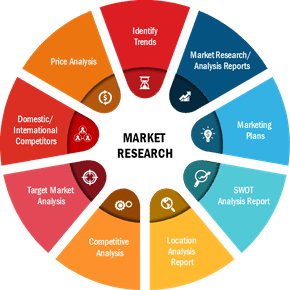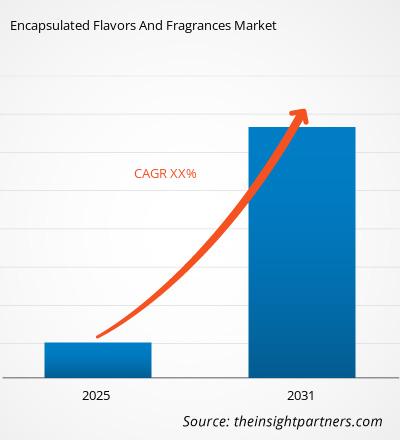L'encapsulation ou micro encapsulation d'arôme consiste à protéger un agent aromatisant ou des molécules de parfum avec une enveloppe spécifique. L'encapsulation peut minimiser la dégradation ou la perte de saveur ou de parfum au cours des différents processus et stockage des produits. L'enveloppe peut également fournir des propriétés fonctionnelles telles que la libération contrôlée de molécules aromatiques dans un environnement donné.
DYNAMIQUE DU MARCHÉ
Le marché des arômes et parfums encapsulés a connu une croissance significative en raison de facteurs tels que la préférence croissante des consommateurs pour des produits alimentaires pratiques tels que des collations prêtes à manger aromatisées et nutritives. Les clients apprécient aujourd'hui l'idée des saveurs dans différents types de produits alimentaires tels que les biscuits, les biscuits, les glaces, etc., ce qui devient aujourd'hui un phénomène dans l'industrie alimentaire et des boissons. La forte demande des clients pour l’arôme et le parfum originaux des produits est l’un des principaux moteurs du marché des arômes et parfums encapsulés. Les pays développés comme les États-Unis, le Royaume-Uni, l'Allemagne, le Japon, etc. développent leur technologie parallèlement aux installations de R&D alimentaires ainsi qu'à l'industrie de l'encapsulation aromatisée que les producteurs peuvent facilement adopter, et ce développement technologique stimule également le demande. Cependant, les clients d'aujourd'hui soucieux de leur santé sont toujours curieux de savoir tout ce qui entre dans leur alimentation et de savoir si la réglementation alimentaire l'autorise. Le respect du maintien de la qualité du produit final et des normes réglementaires est l’un des principaux freins à la croissance des acteurs du marché. La croissance significative des industries de transformation des aliments dans les pays développés et en développement contribue également à la croissance du marché des arômes et parfums encapsulés.
PORTÉE DU MARCHÉ
L'analyse du marché mondial des arômes et parfums encapsulés jusqu'en 2031" est une étude spécialisée et approfondie de l'industrie alimentaire et des boissons avec un accent particulier sur l'analyse des tendances du marché mondial. Le rapport vise à fournir un aperçu du marché mondial des arômes et parfums encapsulés avec une segmentation détaillée du marché par type, canal de distribution et géographie. Le marché mondial des arômes et parfums encapsulés devrait connaître une forte croissance au cours de la période de prévision. Le rapport fournit des statistiques clés sur l'état du marché des principaux arômes et parfums encapsulés au monde et présente les principales tendances et opportunités sur le marché.
SEGMENTATION DU MARCHÉ
Les arômes et parfums encapsulés mondiaux sont segmentés en fonction du type de produit, de la technologie et de l'application. Sur la base du type de produit, le marché mondial des arômes et parfums encapsulés peut être segmenté en mélanges d’arômes, mélanges de parfums, huiles essentielles, extraits naturels et produits chimiques aromatiques. Sur la base de la technologie, les arômes et parfums encapsulés globaux sont segmentés en processus physique, processus physico-chimique, processus chimique, extrusion, lit fluidisé et autres. Sur la base de l'application, le marché mondial des arômes et parfums encapsulés peut être segmenté en aliments et boissons, articles de toilette, nettoyants et autres.

Le rapport fournit un aperçu détaillé de l'industrie, comprenant des informations qualitatives et quantitatives. Il fournit un aperçu et des prévisions du marché mondial des arômes et parfums encapsulés en fonction de divers segments. Il fournit également la taille du marché et des estimations prévisionnelles pour la période 2021 à 2031 pour cinq grandes régions, à savoir : Amérique du Nord, Europe, Asie-Pacifique (APAC), Moyen-Orient et Afrique (MEA) et Amérique du Sud. Le marché mondial des arômes et parfums encapsulés de chaque région est ensuite sous-segmenté par pays et segments respectifs. Le rapport couvre l'analyse et les prévisions de 18 pays dans le monde ainsi que la tendance actuelle et les opportunités qui prévalent dans la région.
Le rapport analyse les facteurs affectant le marché mondial des arômes et parfums encapsulés du côté de la demande et de l'offre et évalue plus en détail la dynamique du marché affectant le marché au cours de la période de prévision, c'est-à-dire les moteurs, les contraintes, les opportunités et l'avenir. s'orienter. Le rapport fournit également une analyse PEST exhaustive pour les cinq régions, à savoir : Amérique du Nord, Europe, APAC, MEA et Amérique du Sud après avoir évalué les facteurs politiques, économiques, sociaux et technologiques affectant les arômes et parfums encapsulés mondiaux dans ces régions.

ACTEURS DU MARCHÉ
Les rapports couvrent les développements clés du marché mondial des arômes et parfums encapsulés en tant que stratégies de croissance organique et inorganique. Diverses entreprises se concentrent sur des stratégies de croissance organique telles que les lancements de produits, les approbations de produits et d'autres telles que les brevets et les événements. Les activités de stratégies de croissance inorganiques observées sur le marché étaient des acquisitions et des partenariats et des partenariats. collaborations. Ces activités ont ouvert la voie à l’expansion des activités et de la clientèle des acteurs du marché. Les payeurs du marché des arômes et parfums encapsulés mondiaux devraient bénéficier d’opportunités de croissance lucratives à l’avenir avec la demande croissante d’arômes et de parfums encapsulés sur le marché mondial. Vous trouverez ci-dessous la liste de quelques entreprises engagées dans le secteur mondial des arômes et parfums encapsulés.
Le rapport comprend également les profils des entreprises clés ainsi que leur SWOT. analyse et stratégies de marché sur le marché mondial des arômes et parfums encapsulés. En outre, le rapport se concentre sur les principaux acteurs de l'industrie avec des informations telles que les profils d'entreprise, les composants et les services proposés, les informations financières des 3 dernières années, l'évolution clé des cinq dernières années.
- •AVEKA•BÜCHI Labortechnik AG•Cargill•Firmenich SA•FONA International Inc.,•Glatt GmbH•Ingredion Incorporated•Lycored•Sensient•Tate & Lyle plc
L'équipe de recherche et d'analyse dédiée d'Insight Partner est composée de professionnels expérimentés dotés d'une expertise statistique avancée et propose diverses options de personnalisation dans l'étude existante.

- Analyse historique (2 ans), année de base, prévision (7 ans) avec TCAC
- Analyse PEST et SWO
- Taille du marché Valeur / Volume - Mondial, Régional, Pays
- Industrie et paysage concurrentiel
- Ensemble de données Excel



Report Coverage
Revenue forecast, Company Analysis, Industry landscape, Growth factors, and Trends

Segment Covered
This text is related
to segments covered.

Regional Scope
North America, Europe, Asia Pacific, Middle East & Africa, South & Central America

Country Scope
This text is related
to country scope.
Trends and growth analysis reports related to Food and Beverages : READ MORE..
The List of Companies
1. AVEKA
2. BÜCHI Labortechnik AG
3. Cargill
4. Firmenich SA
5. FONA International Inc.,
6. Glatt GmbH
7. Ingredion Incorporated
8. Lycored
9. Sensient
10. Tate and Lyle plc
The Insight Partners performs research in 4 major stages: Data Collection & Secondary Research, Primary Research, Data Analysis and Data Triangulation & Final Review.
- Data Collection and Secondary Research:
As a market research and consulting firm operating from a decade, we have published and advised several client across the globe. First step for any study will start with an assessment of currently available data and insights from existing reports. Further, historical and current market information is collected from Investor Presentations, Annual Reports, SEC Filings, etc., and other information related to company’s performance and market positioning are gathered from Paid Databases (Factiva, Hoovers, and Reuters) and various other publications available in public domain.
Several associations trade associates, technical forums, institutes, societies and organization are accessed to gain technical as well as market related insights through their publications such as research papers, blogs and press releases related to the studies are referred to get cues about the market. Further, white papers, journals, magazines, and other news articles published in last 3 years are scrutinized and analyzed to understand the current market trends.
- Primary Research:
The primarily interview analysis comprise of data obtained from industry participants interview and answers to survey questions gathered by in-house primary team.
For primary research, interviews are conducted with industry experts/CEOs/Marketing Managers/VPs/Subject Matter Experts from both demand and supply side to get a 360-degree view of the market. The primary team conducts several interviews based on the complexity of the markets to understand the various market trends and dynamics which makes research more credible and precise.
A typical research interview fulfils the following functions:
- Provides first-hand information on the market size, market trends, growth trends, competitive landscape, and outlook
- Validates and strengthens in-house secondary research findings
- Develops the analysis team’s expertise and market understanding
Primary research involves email interactions and telephone interviews for each market, category, segment, and sub-segment across geographies. The participants who typically take part in such a process include, but are not limited to:
- Industry participants: VPs, business development managers, market intelligence managers and national sales managers
- Outside experts: Valuation experts, research analysts and key opinion leaders specializing in the electronics and semiconductor industry.
Below is the breakup of our primary respondents by company, designation, and region:

Once we receive the confirmation from primary research sources or primary respondents, we finalize the base year market estimation and forecast the data as per the macroeconomic and microeconomic factors assessed during data collection.
- Data Analysis:
Once data is validated through both secondary as well as primary respondents, we finalize the market estimations by hypothesis formulation and factor analysis at regional and country level.
- Macro-Economic Factor Analysis:
We analyse macroeconomic indicators such the gross domestic product (GDP), increase in the demand for goods and services across industries, technological advancement, regional economic growth, governmental policies, the influence of COVID-19, PEST analysis, and other aspects. This analysis aids in setting benchmarks for various nations/regions and approximating market splits. Additionally, the general trend of the aforementioned components aid in determining the market's development possibilities.
- Country Level Data:
Various factors that are especially aligned to the country are taken into account to determine the market size for a certain area and country, including the presence of vendors, such as headquarters and offices, the country's GDP, demand patterns, and industry growth. To comprehend the market dynamics for the nation, a number of growth variables, inhibitors, application areas, and current market trends are researched. The aforementioned elements aid in determining the country's overall market's growth potential.
- Company Profile:
The “Table of Contents” is formulated by listing and analyzing more than 25 - 30 companies operating in the market ecosystem across geographies. However, we profile only 10 companies as a standard practice in our syndicate reports. These 10 companies comprise leading, emerging, and regional players. Nonetheless, our analysis is not restricted to the 10 listed companies, we also analyze other companies present in the market to develop a holistic view and understand the prevailing trends. The “Company Profiles” section in the report covers key facts, business description, products & services, financial information, SWOT analysis, and key developments. The financial information presented is extracted from the annual reports and official documents of the publicly listed companies. Upon collecting the information for the sections of respective companies, we verify them via various primary sources and then compile the data in respective company profiles. The company level information helps us in deriving the base number as well as in forecasting the market size.
- Developing Base Number:
Aggregation of sales statistics (2020-2022) and macro-economic factor, and other secondary and primary research insights are utilized to arrive at base number and related market shares for 2022. The data gaps are identified in this step and relevant market data is analyzed, collected from paid primary interviews or databases. On finalizing the base year market size, forecasts are developed on the basis of macro-economic, industry and market growth factors and company level analysis.
- Data Triangulation and Final Review:
The market findings and base year market size calculations are validated from supply as well as demand side. Demand side validations are based on macro-economic factor analysis and benchmarks for respective regions and countries. In case of supply side validations, revenues of major companies are estimated (in case not available) based on industry benchmark, approximate number of employees, product portfolio, and primary interviews revenues are gathered. Further revenue from target product/service segment is assessed to avoid overshooting of market statistics. In case of heavy deviations between supply and demand side values, all thes steps are repeated to achieve synchronization.
We follow an iterative model, wherein we share our research findings with Subject Matter Experts (SME’s) and Key Opinion Leaders (KOLs) until consensus view of the market is not formulated – this model negates any drastic deviation in the opinions of experts. Only validated and universally acceptable research findings are quoted in our reports.
We have important check points that we use to validate our research findings – which we call – data triangulation, where we validate the information, we generate from secondary sources with primary interviews and then we re-validate with our internal data bases and Subject matter experts. This comprehensive model enables us to deliver high quality, reliable data in shortest possible time.

 Obtenez un échantillon gratuit pour ce rapport
Obtenez un échantillon gratuit pour ce rapport